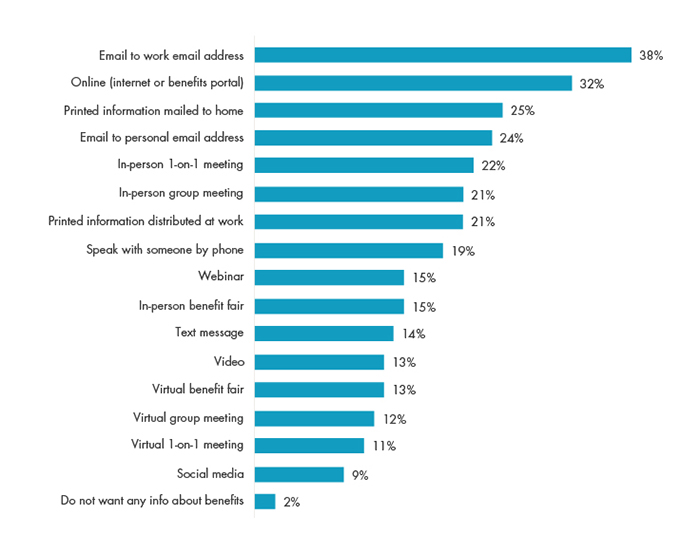Targeting Benefits Communication to
Employee Preferences

Targeting Benefits Communication to
Employee Preferences

November 2022
As employers seek to meet the needs of their employees and win the war for talent, the number and variety of available workplace benefits have proliferated in recent years. While it is undoubtedly beneficial for employees to have more benefits to choose from, workers often struggle to make sense of all their options during the brief open enrollment window. It is critical for employees to understand these offerings, particularly as high overall inflation makes them more cautious with their spending. At the same time, the enrollment process is increasingly shifting to a digital, self-service model where employees make selections with minimal hands-on guidance and support.
In this environment, it is important to communicate benefits information to employees clearly and effectively, so they can make the best enrollment decisions for themselves and their families. In fact, LIMRA research shows that workers who say their employers communicate well about benefits tend to understand their options better and be more satisfied with their overall benefit packages.
To communicate effectively, employers should match their efforts to employees’ preferred methods of learning about this topic. However, employee preferences for how they want to receive benefits information during open enrollment vary considerably from person to person. In fact, fewer than 4 in 10 employees chose even the most popular option of an email sent to a work address (Figure 1). However, some key themes do emerge.

Note: Based on employees who are offered insurance benefits and have had an open enrollment within the past two years. Multiple responses allowed.
Source: 2022 BEAT Study: Benefits and Employee Attitude Tracker, LIMRA, 2022.
While specific preferences vary, a large majority (80 percent) of employees want to receive benefits information through some sort of digital channel, which could include email, benefits portals, webinars, text messages, videos, virtual meetings, or social media. Although Gen Z employees express the greatest interest in digital channels, even 71 percent of Baby Boomers prefer some type of digital communication. At this point, it is essential for digital (and mobile) capabilities to be an integral part of employers’ communication strategies.
Email is the most popular of the digital channels, with just over half of all employees preferring to receive benefits information through either work or personal email accounts. Work email addresses are favored over personal ones, although employees in some industries may not have work email accounts available.
In contrast, employees express relatively low interest in receiving benefit communications through text messages, videos, or social media. However, attitudes toward these channels vary by age, with younger workers displaying considerably more interest in all three. Among Gen Z employees, 41 percent would like to receive benefits information by text message, 20 percent prefer videos, and 21 percent prefer social media. Employers with younger workforces may opt to use some of these communication methods, but they should not rely solely on these channels, since many workers will not want to use them. However, some of these approaches may increase in popularity over time, as the younger generations gradually make up greater proportions of the workforce.
Despite their affinity for digital channels, many employees also express a strong desire for two-way communication methods that allow them to speak with a real person and ask questions. Altogether, 63 percent of workers prefer some type of interactive method of communication, including in-person or virtual meetings, benefit fairs, webinars, or the option to speak with someone by phone. Younger workers, who tend to be less familiar with benefits and more likely to have questions, are the most interested in these modes of communication.
Employees express similar levels of interest in both group and one-on-one benefits meetings. These are likely to serve different purposes, with group meetings better for conveying general information and updates, while one-on-one meetings allow employees to ask questions confidentially and receive personalized advice. Employees also express more desire for in-person rather than virtual meetings, despite the continued prevalence of hybrid and remote work. This may be a symptom of “Zoom fatigue” and the limitations that a purely digital experience presents.
An employer’s approach to personal, interactive communications will depend a great deal on the size and distribution of its workforce, as well as the nature of the work. Regardless of the format, however, including a human component in the benefit communications strategy can provide value to employees who need guidance.
In today’s digital-first environment, it is no surprise that only 36 percent of workers prefer to receive printed benefits information, either at home or at work. Home mailings are slightly preferred over materials distributed at the workplace, possibly because so many people are now working remotely at least some of the time. In addition, employees can easily share content mailed to their home with a spouse or partner, with whom they may need to coordinate coverage decisions.
Employees working in the accommodation, food service, and retail trade industries are the most receptive to printed benefit materials, perhaps because these workers often do not have computer-based jobs. Older workers, those with lower incomes, and those who rarely or never work remotely are also more likely to want printed information.
The days of a single-channel approach to benefits communication are over. As employers strive to improve employee understanding in an increasingly complex benefits landscape, the best strategy will be an omnichannel approach that leverages multiple communication methods. This will allow employees to absorb information in the manner that suits them best, whether that is reading an email, watching a video, or talking with someone in person. By meeting employees where they are and aligning communications to their individual learning styles, employers can increase the odds that workers will gain a clear understanding of their benefit options and make optimal enrollment decisions.
About the ResearchLIMRA’s BEAT (Benefits and Employee Attitude Tracker) is a new annual survey that monitors employee attitudes toward employment in general and benefits in particular. Over 3,000 U.S. employees were surveyed in late 2021 and early 2022. |